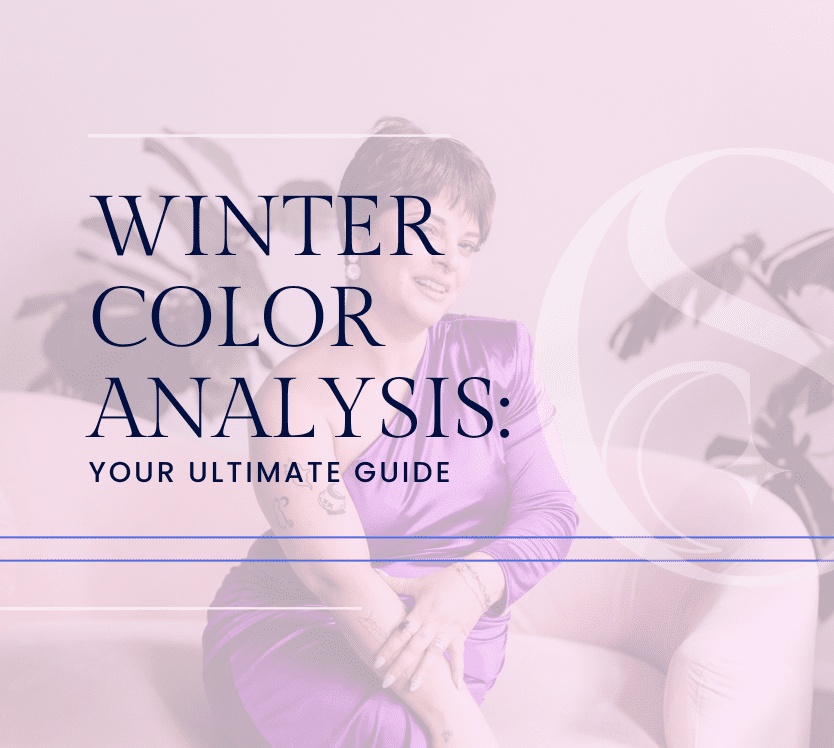Color analysis, a trend that gained popularity in the 80s, is experiencing a resurgence thanks to social media. This method helps you determine which colors complement your natural features best, and TikTok is loving it.
As a personal stylist and a Certified Color Analyst, I want to share more about Winter color analysis and its subsets.
Color Analysis Theory
Color analysis is based on the idea that certain colors can improve your natural skin tone, eye color, and hair color, while others detract from them. There are four main color analysis seasons: Spring, Summer, Autumn, and Winter. Each season has its unique color palettes.
What Is Winter Color Analysis?
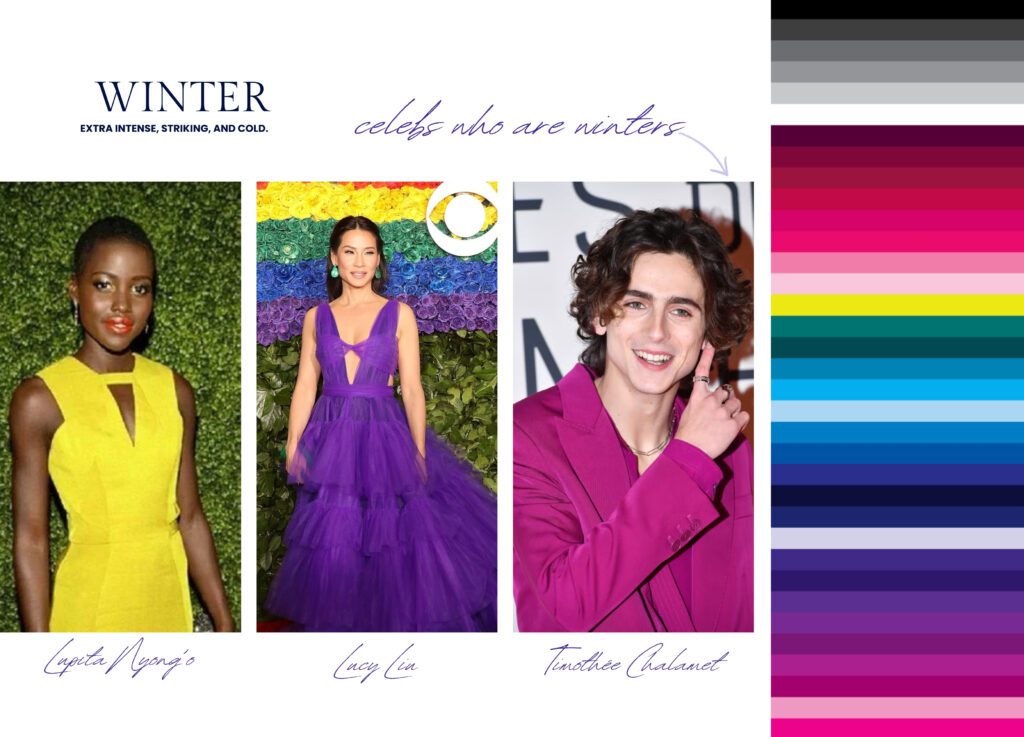
Compared to other seasons, the Winter color analysis palette stands out in a few different ways:
- Contrast: Winters have a high contrast in their natural coloring. This can look like dark hair with fair skin, very bright eyes that stand out against the rest of your complexion, and other high-contrast features.
- Coolness: Winter is a cool season. If you’re a Winter, your skin tone has a blue or blue-red undertone (as opposed to the yellow undertones that Springs and Autumns have).
- Clarity: Winter colors are clear and pure, without any muted or toned-down qualities. This makes them different from Summer (which has soft, muted cool colors) and Autumn (which has warm, muted colors).
- Intensity: The Winter season has the most intense and dramatic colors of all the seasons. Spring colors are also bright, but they don’t have the intensity of Winter colors and are, in general, warmer.
If you are a color analysis Winter, you typically have dark hair, fair skin, and eyes that stand out against your complexion. But there are many exceptions to this “rule.”
For best results when determining your color analysis season, stay away from color analysis apps and get a consultation with a Certified Color Analyst instead.
Color Analysis Winter Palette
The winter color palette has bold and clear colors with cool undertones. These colors are intense and crisp. The typical winter color analysis palette includes:
- Pure white
- Jet black
- Navy blue
- Ice blue
- Emerald green
- Ruby red
- Bright pink
- Lemon yellow
These colors harmonize with the natural high contrast and cool undertones of Winter types.
In fact, some of the Winter season subsets (more on that later) are the only color seasons that can wear true black and actually look good in it.
How Do You Know If You Are a Winter Color?
To figure out if you’re a Winter color season, look for the following “tells”:
- Your skin has cool or blue undertones
- You look better in stark white than in off-white
- Black clothing doesn’t wash you out
- Silver jewelry complements your skin tone better than gold
- Your natural hair color is often dark, dark ash brown, or medium brown (though not always)
- Pastel colors tend to make you look tired or washed out
- Your overall appearance has high contrast (ex: dark hair with light skin)
- Bright, clear colors look good on you
- Your eyes contrast with your skin
If these descriptions resonate with you, you may be a Winter. But getting professional color analysis done will give you a more definitive answer!
Winter Color Analysis Subsets
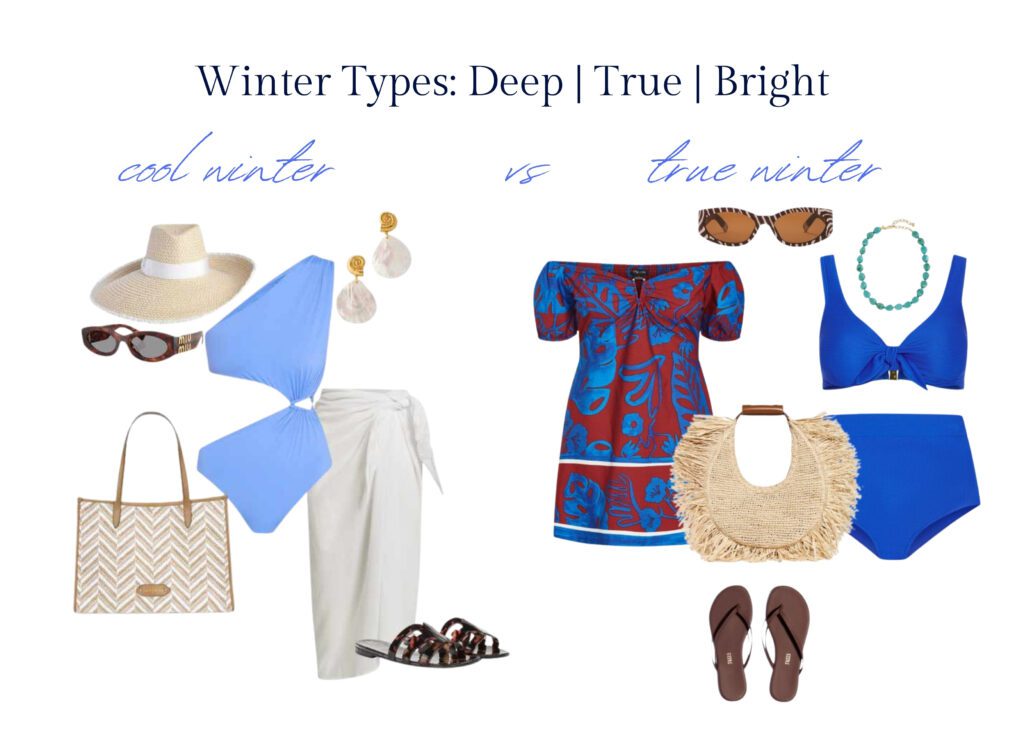
There are three types of Winter color analysis within the Winter season.
Each has its own unique characteristics, and understanding if you belong to the Deep/Dark Winter, True/Cool Winter, or Bright/Clear Winter type can help you find clothes that suit your natural colouring and personal style better.
More and more Americans are following fashion trends – 68% among Gen Z – but color analysis can help you figure out how to make trends work for your individual characteristics.
Deep Winter Color Analysis
Deep Winter, also known as Dark Winter, is a type with deep and rich coloring. If you’re a Deep Winter, you may have very dark hair (usually brown or black), light to medium skin with cool undertones, and eyes that are dark and striking (often brown, dark blue, or dark green).
Deep Winter colours include dark purple, forest green, burgundy, charcoal gray, and other intense, cool-toned colors. Black is highly flattering on Deep Winters, but pure white may sometimes look too stark. Try wearing slightly softer whites instead.
True Winter Color Analysis
The original Winter season is True Winter. It’s also called Cool Winter, and it’s practically the epitome of the high-contrast, intense Winter palette.
True Winters have a distinct blue undertone to their skin and a very high contrast between their hair, skin, and eyes. They also often have very dark hair and very light skin.
The True/Cool Winter palette includes colors like ice blue, true red, fuchsia, bright white, and emerald green, among others.
Bright Winter Color Analysis
Bright Winters have high contrast features and can wear extremely bright colors.
They often have very clear eyes (often bright blue, green, or brown), skin that can be fair or olive-toned but always with a cool undertone, and hair that gives a strong contrast to the skin (can be dark or light).
Vivid, intense colors like electric blue, bright pink, lemon yellow, and vibrant purple look great on Bright Winters. You may also hear “Bright Winter” being referred to as “Clear Winter.”
Winter vs Summer Color Analysis
Winter and Summer are cool-toned seasons, but they’re quite different. Winters have high-contrast coloring and look great when wearing clear and bright colors. They often have dark hair and light skin and can rock pure hues – even challenging ones like true white.
Summers, on the other hand, have low to medium-contrast coloring and look their best in soft and muted colors. If you’re a Summer, you’ll look better in soft ivory than in stark white. Summers also have ashy tones in their hair while Winter hair, whether it’s dark brown or a lighter color, is a much crisper hue.
Overall, Summers shine in lighter and more delicate colors than the Winter palette. For example, a Winter might wear a bright royal blue, but a Summer would look better in a softer – but still cool-toned – blue.
Am I Summer or Winter Palette?
There are a few ways to tell if you’re a Summer or a Winter palette.
First, look at your overall contrast level – high contrast suggests Winter and low contrast suggests Summer. Then, you can do a couple of experiments, such as wearing silver and gold jewelry and seeing which one suits you better. If you look better in silver, you’re probably a Winter. Gold is more of a Summer color.
Winters will also look better wearing bold red lipstick. Summers work better with a soft pink one.
Try experimenting with different shades and seeing if bolder, more intense colors work better with your natural features. If so, then you’re likely a Winter.
Winter vs Autumn Color Analysis
Winter and Autumn are on the opposite ends of the color spectrum. Winters have cool undertones and high-contrast features. They look best in bold, intense, and icy colors. Autumn is a warm season with medium contrast. If you’re an Autumn, you’ll look much better wearing rich and warm colors.
Am I an Autumn or Winter?
Winter and Autumn are quite different from each other, so it should be pretty easy to see if you’re an Autumn or a Winter. If your natural features are warm and medium-contrast, you’re likely an Autumn. If cooler and bolder colors look better on you, you’re probably a Winter.
For example, you can try wearing a warm chocolate brown top and a navy blue one to see which color works best for you. If it’s chocolate, then you’re likely an Autumn.
Winter vs Spring Color Analysis
Winter is a cool season, and Spring is a warm season. Springs look beautiful in clear and bright colors with warm hues. In contrast, Winters look best in cooler and richer colors.
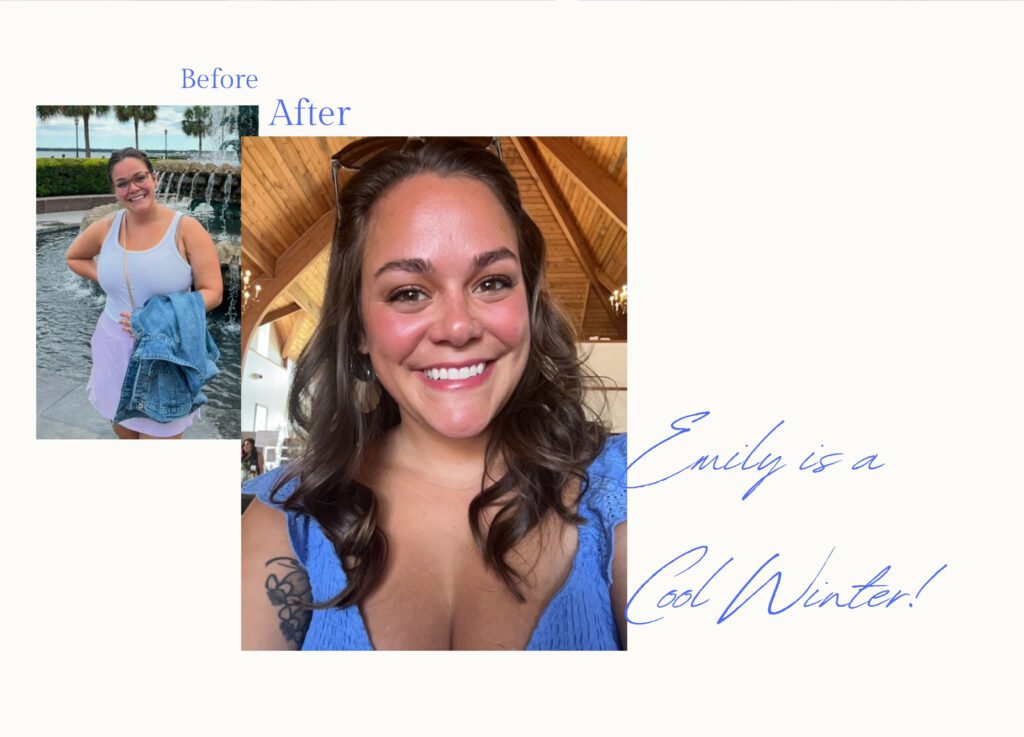
If pastels work better for your wardrobe, you might be a Spring. If bold colors with cool undertones are more flattering, you’re more likely a Winter.
Examples of Winter Color Analysis
With something visual like Winter color analysis, it’s always a good idea to look at examples. Here are a few celebrities who could be Winters!
Winter Color Analysis Celebrities
Lupita Nyong’o
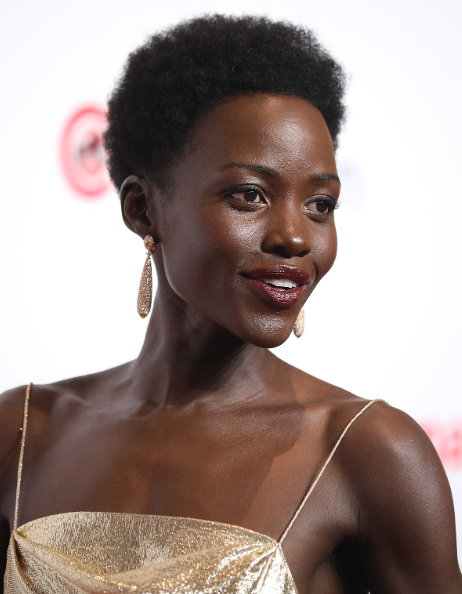
Lupita Nyong’o is an example of a Bright Winter. She looks striking in bold colors that might overwhelm others. Her high-contrast features and ability to wear extremely bright colors are good indicators of the Bright Winter subtype.
Anne Hathaway
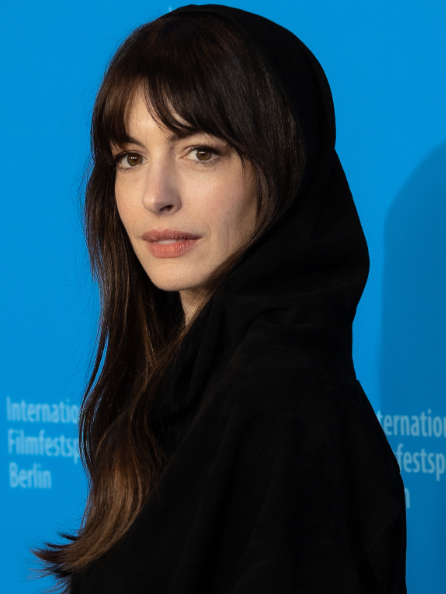
Anne Hathaway is often categorized as a True Winter. She looks exceptional in high-contrast outfits and cool-toned colors. Her pale skin, dark hair, and bright dark eyes create the high contrast typical of the Winter season.
Kim Kardashian
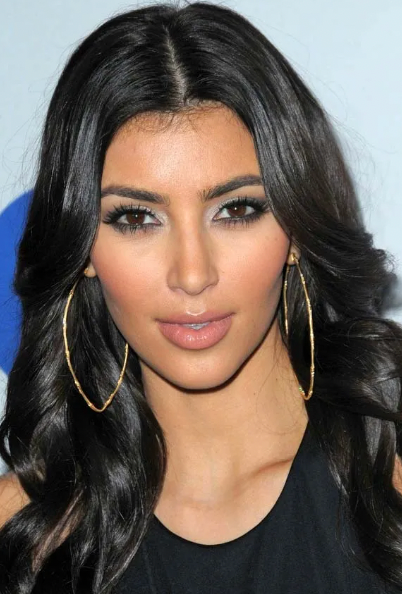
Kim Kardashian could be a Deep Winter. She often wears rich, dark colors and is one of the few people who can wear all-black outfits and still look good.
Which Winter Am I? (Color Analysis)
It’s important to know your Winter season subtype and the best way to do that is to book a consultation with a Certified Color Analyst. An expert can analyze your skin’s undertone, the level of contrast in your natural coloring, and what different colors do to your appearance.
FAQs
Can Winters Wear Yellow?
Yes, Winters can wear yellow, but the shade is important. Clear, lemon yellows are better than mustardy or golden yellows. Bright, cool yellows can look good on Winters, especially as accent colors.
Can Winters Have Hazel Eyes?
Yes, Winters can have hazel eyes. Many Winters have blue, green, or brown eyes, but eye color alone doesn’t determine your season. The overall contrast and coolness of your features are more important. If your Hazel eyes are clear and in high contrast with your skin and hair, you could still be a Winter.
Can Winters Wear Orange?
Orange is typically a warm color, so it can be challenging for Winters. That said, a clear, bright coral-orange can work, especially as an accent color. If you want to wear orange, look for clothes made with cooler and clearer shades of orange.
Do Winters Look Good in White?
True white is often a good color for most Winters. It provides a striking contrast with your coloring and can create a vibrant appearance. But make sure you’re wearing true white – off-white or cream are warmer and can clash with the cool undertones of Winter coloring.
Can a Winter Wear Sage Green?
Sage green is typically a muted color, so it looks better on Autumn or Summer types. But if you want to wear sage green as a Winter, you can try pairing it with clearer and cooler colors from your palette or choosing other shades of green, such as mint or seafoam green.
Can Winters Wear Gold?
Silver typically looks better on Winter types, but white gold or very bright, clear yellow gold can still work. Avoid muted, antique, or rose golds, and try to go for cooler-toned or bright versions of the metal. Basically, the cooler the shade of gold, the better it’ll look.
What Colors Should Cool Winters Avoid?
Cool Winters should avoid warm and muted colors such as oranges, warm browns, olive greens, muted yellows, and warm beiges. Instead, focus on clear and cool colors, including jewel tones, icy pastels, and stark neutrals like black and white.
What Hair Color Is Best for True Winter?
True Winters often look best with cool, dark hair colors. Jet black, cool dark brown, or deep blue-black can look fabulous. For lighter options, icy platinum can work well, too. The key is to maintain high contrast with the skin and to choose colors with cool undertones.
How Do I Tell If I’m a Summer or Winter?
The key difference between Summers and Winters is color intensity. Winters look best in clear and bright colors. Summers are all about soft and muted shades. If you look better in a true white T-shirt, you’re probably a Winter. If a soft pink t-shirt is better, then you’re likely a Spring.
Is There a Soft Winter Color Palette?
As a Certified Color Analyst, I don’t recognize “Soft Winter” as a Winter subtype. Some systems do include a “soft” or “muted” Winter subtype. This would apply to people who have primarily Winter characteristics but look better in slightly softer versions of Winter colors. Basically, a soft Winter would be a mix between a Winter and a Summer.
How to Figure Out Your Seasonal Color Palette
Guidelines and education are helpful, but the most accurate way to determine your seasonal color palette is through a 1:1 consultation with a Certified Color Analyst. Book yours now!
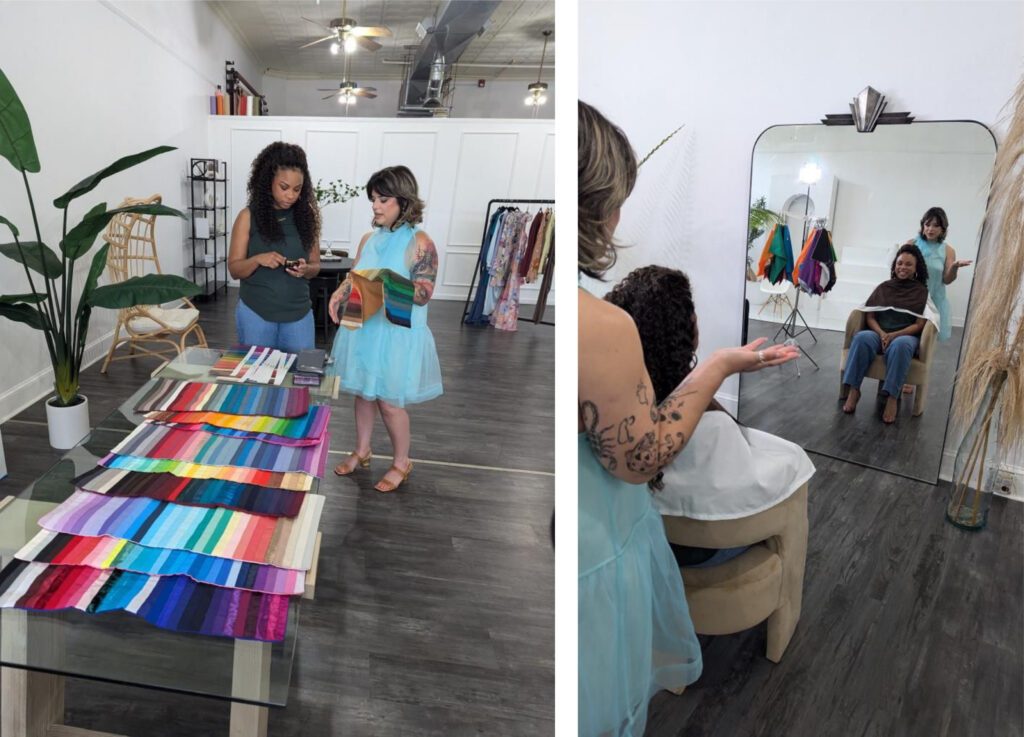
P.S. Want more personalized style guidance? Check out my styling packages or tune in to my podcast on Apple or Spotify where we talk all things style, confidence, and authenticity!
